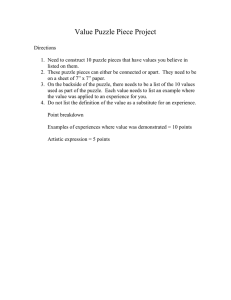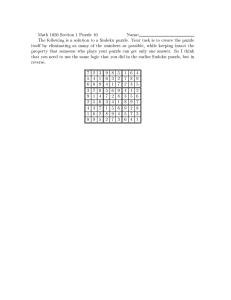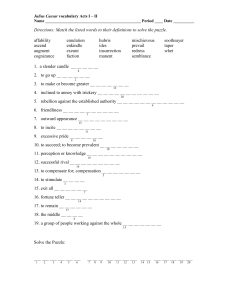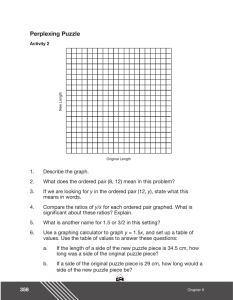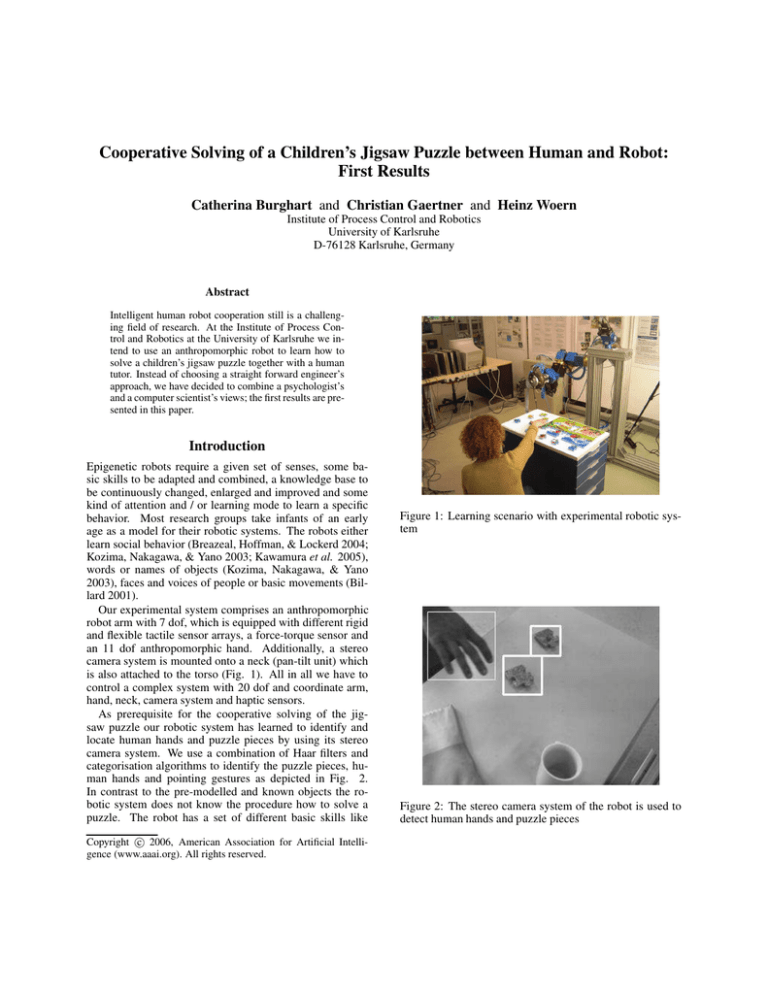
Cooperative Solving of a Children’s Jigsaw Puzzle between Human and Robot:
First Results
Catherina Burghart and Christian Gaertner and Heinz Woern
Institute of Process Control and Robotics
University of Karlsruhe
D-76128 Karlsruhe, Germany
Abstract
Intelligent human robot cooperation still is a challenging field of research. At the Institute of Process Control and Robotics at the University of Karlsruhe we intend to use an anthropomorphic robot to learn how to
solve a children’s jigsaw puzzle together with a human
tutor. Instead of choosing a straight forward engineer’s
approach, we have decided to combine a psychologist’s
and a computer scientist’s views; the first results are presented in this paper.
Introduction
Epigenetic robots require a given set of senses, some basic skills to be adapted and combined, a knowledge base to
be continuously changed, enlarged and improved and some
kind of attention and / or learning mode to learn a specific
behavior. Most research groups take infants of an early
age as a model for their robotic systems. The robots either
learn social behavior (Breazeal, Hoffman, & Lockerd 2004;
Kozima, Nakagawa, & Yano 2003; Kawamura et al. 2005),
words or names of objects (Kozima, Nakagawa, & Yano
2003), faces and voices of people or basic movements (Billard 2001).
Our experimental system comprises an anthropomorphic
robot arm with 7 dof, which is equipped with different rigid
and flexible tactile sensor arrays, a force-torque sensor and
an 11 dof anthropomorphic hand. Additionally, a stereo
camera system is mounted onto a neck (pan-tilt unit) which
is also attached to the torso (Fig. 1). All in all we have to
control a complex system with 20 dof and coordinate arm,
hand, neck, camera system and haptic sensors.
As prerequisite for the cooperative solving of the jigsaw puzzle our robotic system has learned to identify and
locate human hands and puzzle pieces by using its stereo
camera system. We use a combination of Haar filters and
categorisation algorithms to identify the puzzle pieces, human hands and pointing gestures as depicted in Fig. 2.
In contrast to the pre-modelled and known objects the robotic system does not know the procedure how to solve a
puzzle. The robot has a set of different basic skills like
c 2006, American Association for Artificial IntelliCopyright gence (www.aaai.org). All rights reserved.
Figure 1: Learning scenario with experimental robotic system
Figure 2: The stereo camera system of the robot is used to
detect human hands and puzzle pieces
Figure 4: Experimental set-up for study
Figure 3: Approach for the cooperative puzzle solving
autonomous movements, gripping an object, being manually guided either at the robot hand or at the forearm, elbow or upper arm (Yigit, Burghart, & Woern 2003; 2004;
Kerpa et al. 2003). These basic skills can be monitored and
stored as a sequence of parametricable actions in a database.
Solving a children’s jigsaw puzzle in cooperation with a
robotic system allows different forms of cooperation. First
of all the context and the environment have to be contemplated. The context in this case is the task to cooperatively
fit the puzzle pieces together, which can be contemplated as
enclosing context coupling human and robot. Besides this
overall task different subtasks can be made out as context
forming a basis for the human-robot-team. These subtasks
can be: turning all jigsaw pieces to the correct side at the beginning, sorting pieces, looking for specific pieces, or building the edge or a designated part of the puzzle. As it is
intended that our robotic system learns the way to solve a
puzzle by tutelage further forms of cooperation have to be
taken into account. As the robot is not equipped with speech
recognition at present, only actions envolving manual guiding of the robot arm and hand or interpreting the appropriate action by using the camera system are considered. We
do not use learning by imitation or demonstration. In these
cases we either have a direct physical coupling between robot and human partner or a visual coupling via the stereo
camera system besides the coupling by a given context or
task.
Instead of using a straight forward engineer’s approach to
realize the cooperative solving of a jigsaw puzzle we have
decided to also take a psychological approach into account
and combine both methods to achieve an optimal result (Fig.
3). Therefore, we started to look at the different forms of
knowledge representation, actions and facts in psychology
as well as learning procedures of children. We performed
an actual puzzle solving experiment with a child in order to
gain some information on a child’s way to tackle the puzzle
problem. Then possible actions of a learning robotic system were modelled and are used as entry for a simulation in
ACT-R.
This paper is organised as follows: Section II illustrates
the learning experiment of the selected child. The modelling
of the robot learning scenario in ACT-R is depicted in Section III, whereas the integration of ACT-R as planning module in the cognitive architecture of our robot is described in
Section IV. Section V concludes this paper.
Learning Experiment
As a first step to describe and model the behavior when
learning to solve a puzzle and cooperatively solving the
same we have performed an experiment using a three year
old child. The idea was to closely watch the child, analyze and describe its behavior and try to transfer appropriate
models, ways of learning and behaviors onto our robotic system. Though watching only one child is not representative
in terms of a psychological experiment, the analyzed behavior can still be used as model for an appropriate behavior of
the robotic system.
Experimental Set-Up
For our experiment we used a three year old girl who was
familiar with the way of solving a puzzle (Fig. 4); that
is she knew what to do with different pieces of a puzzle
which seemed to fit together. The girl was given a jigsaw
puzzle of 54 pieces, which is also intended for the robotic
experiments. The puzzle pictures a natural scene of animals
(horses, goats, cows and pigs) on a mountain pasture. The
material is foamed rubber, 1 cm thick, blue on the back and
coloured (printed picture) in front. There are only nine different types of pieces which thus makes solving the puzzle
slightly more difficult for the child. The puzzle itself and
the picture on the puzzle were unknown to the child. Also,
the picture was not presented during the puzzling process.
The girl solved the puzzle four times with the mother acting
as tutor. Each time the mother helped less until there was
practically no interference in the puzzling process the last
two times. All sessions were recorded on video and later
minutely analyzed with the help of a software by William L.
Figure 5: Results of the puzzle solving experiment
Roberts “Programs for the Collection and Analysis of Observational Data.” For this purpose all persons and objects
involved in the process were described as well as all single
actions performed by either the child and/or the mother. All
actions that can be observed have to be coded in tuples of
the following form:
(Acting person, action, goal)
We coded the following actions, which can be divided
into actions concerning the complete puzzle or all pieces,
actions used to find or fit a piece, actions for interacting
with the other person present, which are depicted in Table
1. All these actions were watched and analyzed as they
were performed by the mother and / or the daughter. During the coding process groups of actions belonging together
were formed in order to achieve a clear representation for
the analysis. Additionally, all actors and objects had to be
coded, as pictured in Table 2.
Coding the following action “the child grips a piece, turns
it, positions it and fits it” looks as follows:
1
1
1
1
11
12
40
20
00
01
02
03
04
05
10
11
12
13
20
21
22
30
31
32
40
41
42
50
51
52
53
60
61
63
64
65
66
67
Table 1: Coded Actions
Empty puzzle box
Accumulate pieces
Destruct puzzle
Shuffling pieces
Put away puzzle box
Stapling pieces
Searching
Gripping
Turning around
Holding
Fitting
Incorrect fitting
Fitting at other place
Putting back
Loosening piece
Dropping
Positioning
Rotating
Translation of piece
Requesting
Receiving
Handing over
Showing
Questioning
Looking
Talking
Being obstinate, defying
Sitting down
Counting
Getting up
5
5
5
5
Experimental Results
The analysis of the four sessions shows a distinctive progress
in the learning process. First of all the time the child needed
to solve the puzzle was significantly reduced from 14.57
minutes with the mother acting as tutor in the first session to
10.58 minutes in the second session. In the third and fourth
session the mother hardly helped at all, safe a small number
of actions the child solved the puzzle by herself. Here, she
also clearly took the lead as a sociological analysis of the
video recordings showed. In the third and fourth session
the child did not want to be the pupil any more. She even
went as far as to test her mother in the third session. The
child deliberately misplaced a piece several times in a row
and watched for the reaction of her mother. Also the number
of actions performed by either child and mother decreased
Table 2:
01
02
03
04
05
06
07
08
09
Coded Actors and Objects
Child
Mother
Edge piece
Corner piece
Puzzle piece
Puzzle combination
Ceiling
Chair
Puzzle box
throughout the four sessions from 697 at the beginning to
385 in the fourth session. In her first attempt, the daughter
often gripped pieces and put them back again. She also often
had to rotate or reposition a piece before fitting it. Also the
number of misfits was relatively high as depicted in Figure
5. As soon as the child had learned, that pieces with blue
belonged to the sky printed on the puzzle and pieces with
green to the meadow, her speed advanced and the number of
rotations and wrong fittings decreased.
The child’s progress can also be seen in the decreasing
number of the mother’s helping actions like helping with the
correct rotation, position or loosening of a wrongly fitted
piece (help puzzling in Figure 5) or like helping the child to
select the correct piece by giving it to her, indicating it or
taking wrong pieces away (help choosing in Figure 5).
The child’s actions involving no interaction with the
mother slightly increased in the third and fourth trial in contrast to the second session. This is due to the fact that on
the one hand the child did not really want any help any more
and that she also tested the mother. On the other hand she
got slightly bored in the third and fourth session, as she already knew the puzzle and longed to go to the refectory of
the university.
This psychological experiment clearly helped to identify
all single actions involved in teaching a child to solve a puzzle by tutelage. It also showed, that learning by tutelage is a
successful way to learn a certain procedure. In order to get
generalised statements about learning to solve jigsaw puzzles by tutelage this experiment should be repeated in form
of a field study involving a representative number of children
aged three and four.
Modelling the Scenario in ACT-R
Cognitive architectures are theories about the functionality
of human mind. They try to derive intelligent behavior from
fundamental assumptions about the functionality of human
mind. These assumptions are based on knowledge gained
from psychological experiments. Cognitive architectures are
used by psycologists to reconstruct the results of psychological experiments. Thereby they want to see into internal
procedures of the human mind.
ACT-R (Anderson 1996) is a cognitive architecture trying
to describe the functionality of human mind with an integrated approach. Following an integrated approach means
that the ACT-R theory is not trying to describe a specific
feature or part of human cognition. It rather wants to emulate the interaction of the mind’s main components in order
to simulate consciousness. Together with assumptions about
the functionality of the human mind ACT-R also describes
the mode of function of visual and auditive perception as
well as manual actions.
The ACT-R framework consists of a programming language to describe knowledge and the human mind’s basic
mode of function. The programming language is used to
describe declarative and procedural knowledge. Declarative
knowledge is the knowledge that describes facts and features
of objects. In ACT-R declarative knowledge is represented
by so called ”chunks”. A chunk can describe for example
the colour or the position of an object. Furthermore declarative knowledge has the property that human consciousness
is aware of it. In ACT-R the second kind of knowledge
is the procedural knowledge. This type of knowledge describes procedures, i.e. the way how something is done. A
procedural piece of knowledge is for example the information, how to look at something or how to press a key on the
keyboard. This sort of knowledge has the property that human consciousness is not aware of it. In ACT-R procedural
knowledge is represented by so called “productions”.
Additionally ACT-R describes interfaces for visual and
auditive perception as well as an interface for manual actions. These interfaces consist of buffers, which contain
declarative knowledge in form of chunks. Knowledge transfer and modification is performed by applying productions
on these buffers. By transferring chunks into interface
buffers or reading new information from them, interaction
with an environment can be implemented.
Apart from modelling the internal functions of the mind
ACT-R also supplies the creation of an environment for the
experiments. In ACT-R an environment can be created in
form of a screen window where text objects can be displayed. Like probands in psychological experiments the
ACT-R model is able to look at the screen window and move
its attention to objets inside the window. Together with the
internal model of mind the model of cognition and environment offers the ability to simulate psychological experiments. In addition the ACT-R framework supplies information about the duration and the accurancy of a model’s
response. Thus it is possible to compare statistical data
from experiments with human probants with statistical data
achieved by multiple runs of the model. Thereby conclusions on internal procedures of the human mind shall be
made possible.
State of the Art
In the past years ACT-R has been used to model and to
simulate in a number of different applications. Examples
are problem solving and decision making (Gunzelmann &
Anderson 2004) (Taatgen 1999) like mathematical problem
solving (Koedinger & Terao 2002) (Koedinger & MacLaren
1997), choice and strategy selection and language processing. As fas as we know, the solely applications of ACT-R in
robotics are used by (Hipp et al. 2005) and (Sofge, Traftton, & Schultz 2002). (Hipp et al. 2005) want to simplify
the handling of a wheelchair by handicaped people. They
use ACT-R in order to interpret given commands in correlation with the actual situation. The intention of the user
is interpreted out of the results gained by the application of
ACT-R and the data supplied by the sensor systems of the
wheelchair. In contrast (Sofge, Traftton, & Schultz 2002)
use ACT-R to simulate human communicative behavior in
human-robot-cooperation. But up to now no research group
has used ACT-R to actually control an intelligent robotic
system on the top-level.
Models
In our set-up the ACT-R framework is used to model cooperative solving of a jigsaw puzzle. The first part of the model
describes the environment of the experiment. The virtual environment for the simulated experiment consists of a screen
window. A screen shot of the screen window is shown in
Figure 6. Inside the screen window puzzle pieces and possible positions of the puzzle pieces are displayed. The environment describes the features of the puzzle pieces and positions, where the puzzle pieces can be placed. Initially, the
puzzle pieces are placed in the upper left area of the screen
window. The puzzle pieces can be joined together in the upper right area of the window. Furthermore, commands from
the tutor and reactions from the model are displayed in the
lower area of the window. Since the commands and reactions are always placed at the same location the robot can
easily find new orders.
This environmental model is necessary to allow interaction between the robot and the tutor. The environmental
model represents the work surface and the puzzle parts. Both
tutor and model can look at the screen window. By keyboard
commands tutor and robot give instructions to the environmental model. The environmental model interprets these instructions and displays the instructions on the window. Thus
puzzle parts can be moved and joined. The environmental
model recognises the different actions. These actions are
the same, which also occurred in the jigsaw puzzle experiment with tutor and child. After confirmation by the tutor,
these actions are executed by the environment.
Besides the environmental model ACT-R is also used to
create a cognitive model of the robot. This model consists
of a number of chunks and productions, which provide fundamental actions like the selection of a suitable action and
a suitable object as well as the interaction with the environment. The system of productions is organized modularly, so
it offers a good scalability for additional actions. The productions do not encode ways how the jigsaw puzzle can be
solved. They only encode ways for retrieving new actions
or objects and for reporting commands to the environmetal
model. The selection of the right sequence of action is not
coded within the model, so it has to be acquired by learning.
It is planned to evaluate symbolic and subsymbolic learning.
As a first step we implemented and evaluated the learning of
action sequences by concatenation. Reinforcemnt learning
and heuristic action selection are implemented into our system at present.
Simulation
The jigsaw puzzle is iterately solved by robot and tutor. The
main sections of the iteration process are shown in Figure
7. During each iteration step a fundamental operation is performed to solve the puzzle. Such a fundamental operation
is for example grabbing a specific puzzle part or moving the
puzzle piece to a position.
Each iteration step is devided into seven sub steps. In the
first step the robot tries to determine an applicable action
and an applicable object. Afterwards the robot suggests the
action and the object to the tutor. During the second substep the tutor decides whether the selected action shall be
executed with the object. If the tutor evaluates the action as
negative, he will demonstrate an action - possibly in connection with an object - to the robot in the third step. This action
Figure 6: Screenshot of the simulation window: upper
left: heap where the puzzle pieces are initially placed, upper right: puzzle pieces, which are already joined together,
lower half: area for commands by the tutor and responses by
the robot
is a hint for the robot to find the right action and object. For
example the tutor points to an object to tell the robot which
part to take next. In addition the tutor has the alternative of
accomplishing own actions. He may insert some parts and
afterwards the robot may continue with his actions.
The robot looks at the type of action and the object and
returns to the first iteration step. The robot selects a new
action and a new object within the context of the action given
by the tutor. In the second iteration step the new selected
action is presented to the tutor again. In case of a positive
evaluation the robot proceeds to the fourth step.
In the fourth step the robot tries to select a proper destination for the puzzle piece. The suggested destination is
presented to the tutor. He evaluates the destination in the
fifth step. If the destination is evaluated as negative, the tutor
demonstrates an action as well as a position to the robot in
the sixth step. The robot returns to the fourth step and selects
a new destination. The new destination is chosen within the
context of the action demonstrated by the tutor. In case of a
positive evaluation of the destination by the tutor the robot
transmits the action, the object and the destination to the environmental model. The model of the environment executes
the action by changing the position and states of the puzzle
piece in an appropriate way. Afterwards the next iteration
step is begun. The iteration is proceeded until the jigsaw
puzzle is finally completed.
The chosen structure of the simulation permits to use as
many types of actions as desired. The succession of choosing an action by the robot and evaluation by the tutor corre-
Time in s
Duration without
learning
Duration with
learning of
productions
Number of loops
Figure 7: Solving the puzzle together: Tutor and robot solve
the puzzle together by iteration. During every iteration step
a fundamental operation is executed. An iteration step is
devided into 7 sub steps within which the applicable actions
are retrieved by the robot, evaluated by the tutor and finally
executed by the model of the environment.
sponds to the situation that the tutor corrects a child or gives
small assistance while solving a puzzle. The better the robot selects the actions and objects, the more independently
the robot solves the puzzle. In a first step we allowed the
concatenation of productions (actions) in order to simulate a
progress in learning. Instead of asking the tutor after every
single iteration step the simulated robot starts to perform interaction steps forming a specific action without asking the
tutor after it has already successfully perfomred thesye iteration steps before hand. Figure 8 shows the comparison
between action sequences that are performed with and without the concatenation of iteration (action) steps. The performance clearly improves up to 30 percent and the interaction
between robot and tutor becomes smoother. In order to improve the selection of actions and objects several learning
procedures besides mere concatenation of productions are
to be implemented and examined in near future. Learning is
possible over the ambiguity of the applicable actions and by
demonstrating successions of interactions.
Integration into the Robotic System
As the Puzzle Project uses the same experimental robotic
system which is also used within some subprojects of the
German Humanoid Project SFB 588 (Dillmann, Becher, &
Steinhaus 2004), the cognitive architecture to be used is already stipulated (Burghart et al. 2005). It is a modified hierarchical three-layered architecture which also uses components tailored towards different congnitive functions. The
single cognitive modules communicte and interact with each
other accross all layers. Robot tasks are coordinated with
the help of Petri-nets. The actual flow of actions is also to
be coded by Petri-nets.
Figure 8: Concatenating actions clearly improves the interaction and reduces time
In order to achieve a fast translation of the simulated scenario onto the real robotic system we have started to combine ACT-R and the robot control as depicted in Figure 9.
The ACT-R scenario as presented in this paper is used as
a component doing task planning, attention control, execution supervision on a higher level, dialogue management and
concotion or optimisation of productions (learning). All relevant productions for the scenario are stored in the ACT-R
component at present. Later on they are to be stored in the
global knowledge base. The programming of interfaces between the ACT-R component and the robot control has already started. A production as coded within the ACT-R simulated scenario is translated into a robot command, which
is coded in form of a Petri-net. Vice versa inputs to the robotic system i.e. acknowledgements of the human, detection
of the human’s hand or of a piece of the jigsaw puzzle are
correlated with productions in the ACT-R scenario.
Conclusion
In this paper we have presented a novel approach to realize a cooperative task between human and robotic system
by combining the approaches of an engineer and a social
scientist. For this purpose a three year old child was closely
watched in her effort to solve a children’s jigsaw puzzle with
the mother acting as tutor. All actions were described, analyzed and transferred into productions applicable to the robotic system. As the robotic system does not use speech
recognition, other senses like haptics and vision were substituted. Instead of receiving spoken instructions the robotic
arm can be manually guided or instructions can be given by
pointing to a puzzle piece or an empty position in the puzzle.
These aspects have been considered when designing the productions simulating the behavior of the robotic system. As
the robot is to learn the procedure to solve a jigsaw puzzle
with the help of a human tutor using the coded productions
(basic robot skills as well as declarative knowledge about
the puzzle and the human hand), the robot learning scenario
has been simulated in ACT-R by allowing a concatenation
Task
knowledge
Top-level
Environment
model
Object
models
ACT-R Puzzle Component
Puzzle piece recognition
Mid-level
Task
coordination
Low-level
Task
execution
Low-level
perception
Actuators
Sensors
Mid-level
perception
Robot movements
Hand detection
Puzzle piece
detection
FTS sensor data
Tactile sensor data
Position sensor data
Software
Robot
hardware
Environment
Figure 9: Integration of the ACT-R puzzle component into
the robot architecture
of successfully performed robotic actions. Additionally, a
visual output in ACT-R has been created simulating the environment, the focus of attention and the execution of actions by robot and human. Next steps include the application of further learning modes like reinforcement learning
and heuristic selection fo actions. Instead of generating a
specific robotic cognitive structure we intend to integrate the
designed ACT-R component into our robotic architecture.
Acknowledgments
This research has been performed at the Institute of Process
Control and Robotics headed by Prof. H. Woern at the University of Karlsruhe.
References
Anderson, J. 1996. Act: A simple theory of complex cognition. American 51:355–365.
Billard, A. 2001. Learning motor skills by imitation: “a
biologically inspired robotic model”. Int. Journal of Cybernetics and Systems 155–193.
Breazeal, C.; Hoffman, G.; and Lockerd, A. 2004. Teaching and working with robots as a collaboration. In Third
International Joint Conference on Autonomous Agents and
Multiagents.
Burghart, C.; Mikut, R.; Holzapfel, H.; Steinhaus, P.; Asfour, T.; and Dillmann, R. 2005. A cognitive architecture
for a humanoid robot: A first approach. In Proc. IEEE Int.
Conf. On Humanoids.
Dillmann, R.; Becher, R.; and Steinhaus, P. 2004. ARMAR
II - a learning and cooperative multimodal humanoid robot
system. International Journal 1:143–155.
Gunzelmann, G., and Anderson, J. 2004. Spatial orientation using map displays: A model of the influence of target
location. In Proceedings of the 26th Annual Conference of
the Cognitive Science Society.
Hipp, M.; Badreddin, E.; Bartolein, C.; Wagner, A.; and
Wittmann, W. 2005. Cognitive modeling to enhance usability of complex technical systems in rehabilitation technology on the example of a wheelchair. In Proceedings of
the 2nd International Conference on Mechatronics.
Kawamura, K.; Dodd, W.; Ratanaswasd, P.; and Gutierrez,
R. 2005. Development of a robot with a sense of self. In
In Proceedings of CIRA 2005.
Kerpa, O.; Osswald, D.; Yigit, S.; Burghart, C.; and Woern,
H. 2003. Arm-hand-control by tactile sensing for human
robot co-operation. In Proc. of Humanoids’2003.
Koedinger, K., and MacLaren, B. A. 1997. Implicit strategies and errors in an improved model of early algebra problem solving. In Proceedings of the Nineteenth Annual Conference of the Cognitive Science Society.
Koedinger, K., and Terao, A. 2002. A cognitive task analysis of using pictures to support pre-algebraic reasoning. In
Proceedings of the Twenty-Fourth Annual Conference of
the Cognitive Science Society.
Kozima, H.; Nakagawa, C.; and Yano, H. 2003. Can a
robot empathize with people? In International Symposium
”Artificial Life and Robotics” (AROB-98, Beppu).
Sofge, D.; Traftton, J.; and Schultz, A. 2002. Human
robot collaboration and cognition with an autonomous mobile robot. In Proceedings of the International Conference
on Intelligent Autonomous Systems IAS 8.
Taatgen, N. 1999. Explicit learning in act-r. In Mind modelling: a cognitive science approach to reasoning.
Yigit, S.; Burghart, C.; and Woern, H. 2003. Specific combined control mechanisms for human robot co-operation.
In In Proceedings ISC 2003.
Yigit, S.; Burghart, C.; and Woern, H. 2004. Co-operative
carrying using pump-like constraints. In Proc. of Intelligent
Robots and Systems (IROS 2004).

